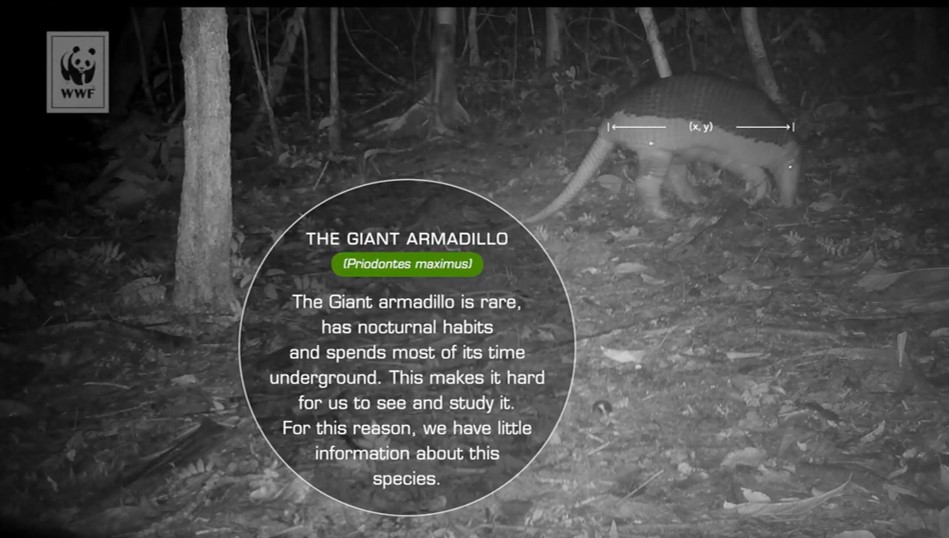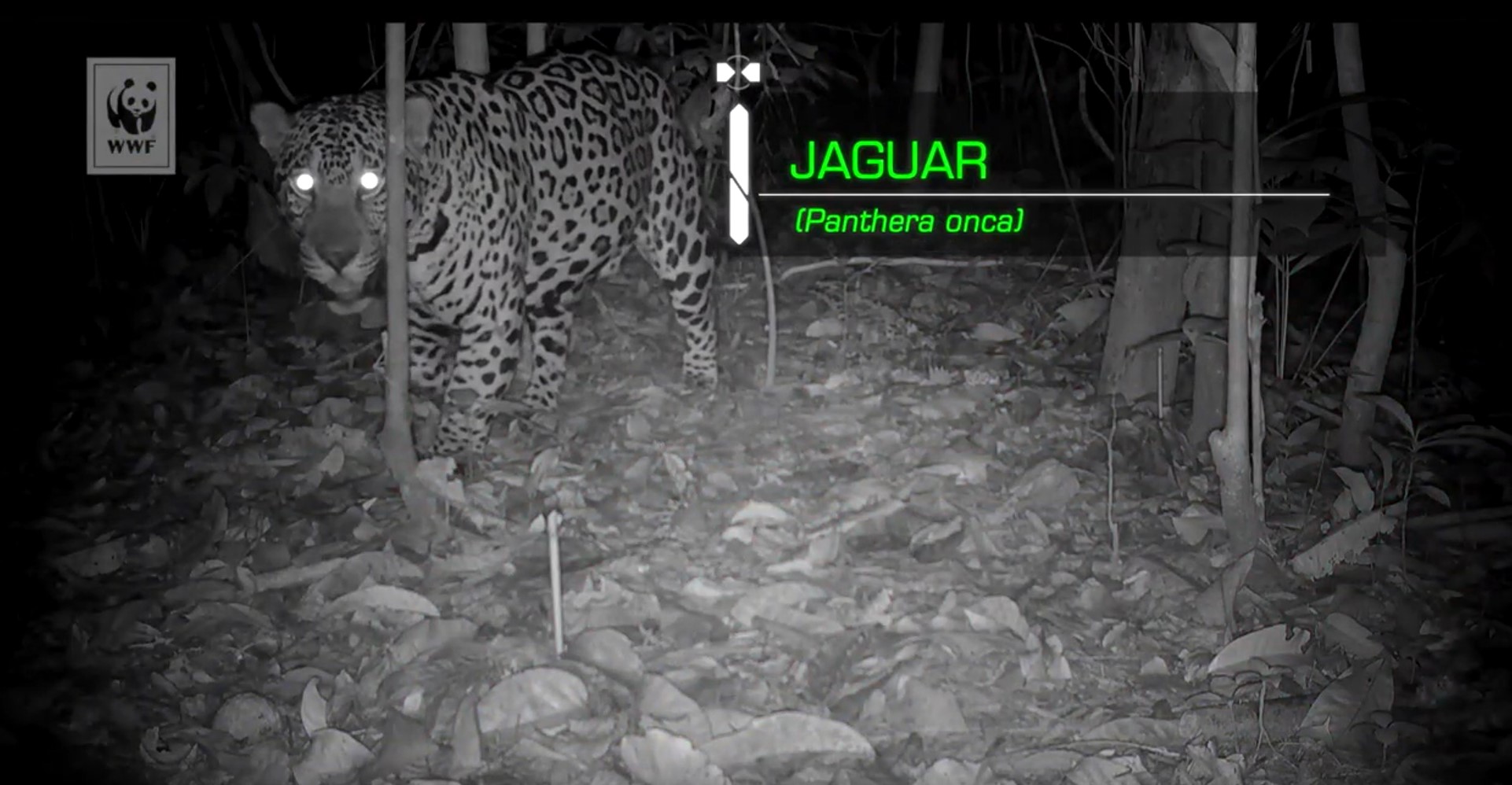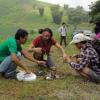Panatraps: 360 camera traps
8 October 2019 11:28am
Looking for opportunity to visit conservationists in Uganda
3 October 2019 2:19pm
Camera Traps and DMR Radio via IP?
26 September 2019 5:33pm
WILDLABS Virtual Meetup: Camera Trapping
26 September 2019 12:00am
WILDLABS Virtual Meetup Series: Season Three
24 September 2019 10:01am
Residents of the Forest: Camera Trap Educational series shows the diversity of Amazon dwellers
25 September 2018 2:52pm
12 July 2019 4:51pm
"Residents of the Forest" Series: New episode brings images of the giant armadillo, the largest and rarest armadillo of the world The Amazon’s armadillos are the protagonists of the eighth episode of the series "Residents of the Forest". The new set of unpublished and exclusive images captured at the Chico Mendes Extractive Reserve, in the state of Acre (AC), shows different species of armadillos and brings various curiosities about one of the most distinctive animals of the Amazonian biome. Among the animals depicted in the film are the Southern naked-tailed armadillo (Cabassous unicinctus), the Nine-banded armadillo (Dasypus novemcinctuo), the Greater long-nosed armadillo (Dasypus kappleri), and the giant armadillo (Priodontes maximus). They are shown digging, feeding, and even bathing! The images come from photographic traps installed inside the Resex.
Read the full story at:
https://www.wwf.org.br/informacoes/english/?72004/Residents-of-the-Forest-Series-New-episode-brings-images-of-the-giant-armadillo-the-largest-and-rarest-armadillo-in-the-world
Check the video at:
https://www.youtube.com/watch?v=X6iKlFJYal4




20 September 2019 4:52pm
Jaguar, cougar, jaguarundis and ocelot: In its last episode, the series “Residents of the Forest” brings images of the Amazon Felids
In its ninth and final episode, the web series “Residents of the Forest”, produced by WWF-Brasil since last year, brings another set of unpublished and exclusive camera-trap images. This time, the stars are the cats of the Amazon. Among the animals depicted in the video are jaguarundis (also known as the "gato-mourisco" or "moorish" cat in Portuguese), ocelots, cougars (also known as pumas), and jaguars.
Recorded during the last few months at the Chico Mendes Extractive Reserve (Resex) in the state of Acre, Brazil, the images were captured through tree-mounted camera traps that have motion sensors and record anything that moves. By doing so, these cameras could record scenes of animals in their natural environments during the day and night.
Watch it and check the playlist with all nine episodes at:
https://www.youtube.com/watch?v=y1aO8739Htk&list=PLFfXasjdYEpLghWXIahnFMlVfrRdPkyBe
Read the full story at:
https://www.wwf.org.br/?72523/Jaguar-cougar-and-ocelot-In-its-last-episode-the-series-Residents-of-the-Forest-brings-images-of-the-large-Amazon-felids


Download the SMART 2018 Annual Report
19 July 2019 4:16pm
20 September 2019 4:47pm
Great work Drew thanks for sharing, hopefully, for the 2019 report, we will have a greater presence of Latin American countries adopting SMART as we have ongoing training activities going on 03 "new smart countries" Brazil, Argentina & Paraguay.
Here is a post about Paraguay first SMART training, hold in the beginning of the month:
https://www.linkedin.com/pulse/paraguay-takes-first-step-towards-adopting-spatial-tool-spina-avino/
Regards!

[ARCHIVED] Camera trap Tech Symposium Nov 7/8th 2019
20 September 2019 7:32am
African leopard research - best camera trap?
3 September 2019 11:29am
19 September 2019 7:16am
Hi Louisa
I have exactly the same questions!
Over the last few years there has been a proliferation of cheap camera traps flooding the market (Apeman, Distianert, Crenova...the list is long). I wouldn't normally recommend budget cameras like these (<$100) for research (quality control issues...), but keen to hear from others if they've worked OK for you.
When I posted a similar question on Twitter, I had a few responses, which might be of interest (one vote for Apeman for arboreal trapping, various votes for Bushnell, which are a bit more expensive).
I think these are all infrared though, not white flash.
If you do take the plunge on some of these cameras, we'd all be interested to hear how you get on!
Thanks
Ollie
Solutions to Camera Trap Theft?
29 October 2017 9:32pm
24 August 2019 4:29pm
A few years ago this solution would have been thought of as nuts.
Have another cheap camera pointing at the expensive camera.
How it would work is like this.
The expensive camera or its housing detects it is being tampered with (tilt detector attached to a microcontroller). The microcontroller is also attached to a small short range radio (NRF24L01). This thing will be asleep all the time and use almost no power, until it is tilted. BOM (bill of materials) less than $10.
The cheap camera is so small it can mostly be buried underground. That is also controlled from a microcontroller, and that too has a small radio. However this radio needs to be listening all the time - BOM will go up with a bigger battery. I've had luck with these cheap 'key fob' 808 cameras, they record video onto their own sd card. BOM probably about $30-40.
Now this wont stop someone stealing the cams, but might lead to an arrest. The argument about sticking a GPS in the housing is not convincing for me, a GPS is a very specific type of pcb usually featuring an easily identifyable antenna - so can just be ripped out. If it were me it would be the first thing I'd look for.
I've used cheap chinese arduino pro-minis and 808 style cams for a while, and while its nice to stick PIRs etc on them to detect intruders etc, the result is usually an empty battery and an sd card full of spider or ant head shots.
If you wanted to scare the wrong-doers off at the moment of theft, then it would be possible to play an audio warning, or shout 'you are now being filmed' or replay the crackle of a walkie-talkie (search : arduino mp3 player). The expensive camera's transmitting radio signal could be picked up by more than one device you see? The noise could be coming from the left, the cam in the ground could be on the right. These simple radios can have a range of 50+ metres, if you pick the right ones. There are other RF options, as well as GSM dialers of course.
If all this sounds a bit complex, with some work and thought these counter measures could be set and forget "black box devices".
12 September 2019 5:08pm
Hi Paul,
Just curious about how you go about interfacing to 808 cameras: part of the problem is you don't always know which exact model you're getting (or at least I don't), how do you work around this?
Some time back I "discovered" the SQ11/SQ12 cameras and bought a couple. Have you had any experience with them? I don't think they're any easier to interface to, but theoretically they should all be identical. A plus is you can get a waterproof housing for them.
Thanks,
-harold
12 September 2019 6:03pm
For the 808s I normally go through links on the chucklohr website, the absolute oracle on 808s. My last purchase were Mate 808 1080P "spy" cameras, with a long camera cable, they do away with the whole plastic housing and just give you the board with components. I ordered from their website in '17, but it seems they are all over the place on ebay ATM.
I tried the SQ11s, but they run awful hot - but for say, 2 minutes of video they work just fine - but minute, I had one working in a hat - thats how I know how hot they can get.
As for "Interface with the 808" I take this to mean 2 things :
a) how do you intercept the video signal to, say, send something to an email address
- you don't, well at least I couldn't, you have to physically go and get the sd card out
b) how do you turn it on an off?
- I unashamedly used this idea from Gordon Williams of Espruino fame :
https://www.espruino.com/Time+Lapse+Camera
You'll notice the clever hack to fire up the cam using 2 i/o pins simultaneously.
Now the cam I mentioned above, like them all, has a config text file, so here you set the image size, whether it starts filming when turned on - with some other basic settings such as date/time etc.
There are lots of gotchas with this, not least of which is when reset that that text file is overwritten with some (sane) defaults, which may not be the default you want.
I found the Mate 808 config did most things, all I had to do was turn the cam on and off - and I got this working with an Arduino pro mini 3.3v.
So the "smarts" can be on an Arduino, read sensors, if/else, film for 30 seconds, 60 seconds, dont film and so on - send an alert etc.
I toyed with the idea of "potting" the cam and Arduino in resin to suit the environment, but as I said, the greater part of it could be buried - just means breaking out the microphone, to say, the same length as the extended camera cable.
The drawback with PIRs I found was all the false positives, had better luck with these small microwave "radar sensors" - Andreas did a fine recap on what was available about 2 years ago.
https://www.youtube.com/watch?v=9WiJJgIi3W0
Machine-readable representation of a sensor duty cycle / recording schedule
11 September 2019 8:13pm
12 September 2019 5:27pm
Hi David,
I use cron-like patterns. One form looks something like: mon,wed-sun 0-23:0-59/10 90
which means every day but Tuesdays, every 10 minutes from the top of the hour, recording for 90 seconds. There is a similar form for matching by month/day. There could be yet another form for sunrise/sunset but I haven't implemented that. Basically a hyphen indicates a range, a comma indicates a list, and the slash is repetition step size. A full recording specification consists of one or more patterns, the first matching being used (for the recording duration). Years are not implemented but that could be done also.
Thanks,
-harold
Advice on Audiomoth extended power and case solution
3 September 2019 5:56pm
6 September 2019 11:21am
Hi Shawn,
I might be concerned about the Li-ion batteries, if there is any chance of losing a node (damage due to installation, weather, animals, or theft) then the economics won't work out, it being such a large proportion of the cost. Also it's kind of a pain flying with them even if they're quite light because they have to go in carry-on luggage.
I'm not insensitive to the e-waste issue, but here I think even here alkaline might have the upper hand: many lithium cells contain toxic cobalt (as opposed to manganese) and it's not often clear which type you have. Alkalines OTOH are relatively innocuous (unless they contain mercury, which they should not in this day and age): carbon anode, steel casing, zinc cathode, zinc oxide (used in baby nappy rash cream), lye, manganese oxide/dioxide (occurs naturally as an ore but you still don't want to eat it).
Thanks,
-harold
6 September 2019 5:29pm
Many thanks Harold!
I really appreciate the information on e-waste! What about going with LiFePo4 batteries? They are consider low toxicity and I know they are a type of battery that our chemistry department will take to recycle (they will also take lipo and li-ion). I am trying to figure out how to calculate battery life in the Audiomoth if I were to go with a higher voltage LiFePo4 but less mAh, say 6.6 volt and 2100/3000 mAh. Any suggestions? and of course thoughts on this option? These batteries are cheaper too ($11-15)!
I've worked a lot with lipo and li-ion batteries building drones and other power solutions so I'm not really worried about damaging them or transporting them. It's amazing how many huge lipo's I've had in my carry-on luggage and all they care about is my laptop! My main concern with alkaline is that they are expensive in Ecuador with no where to dispose of for recyling (yet or that I currently know of). Rechargeables make sense because of the long-life and they can be muled back to the university for recyling with the chemistry department (I have no idea what they do with them, they just want them and say they will be recycled).
Shawn
7 September 2019 12:33am
Hi Shawn,
I've only heard good things about LiFePO4. The only issue I can think of is exactly the one you bring up: the EMF is low enough that a 2S battery is needed. The Audiomoth uses a linear voltage regulator, so anything in excess of the 3.3V that is actually used is wasted. This means for endurance calculations you consider only the mAH rating given you have chosen a battery that will output at least 3.3V (plus a bit more for the dropout). So 2100mAH at 6.6V is just 2100mAH, compared with 5000mAH of your initial Li-ion.
A high-effiency switching regulator may make sense if you're running the Audiomoth at high duty, but even so finding a low power unit is hard. But since reliability is paramount, I would go with something with the fewest moving parts.
Thanks,
-harold
[ARCHIVED] Upcoming Event: First Americas Regional Conference on the Illegal Trade in Wildlife
5 September 2019 7:56pm
Question: applicable AI / ML technologies for customs officials!
5 September 2019 7:41pm
WILDLABS Virtual Meetup Series – Season 3
5 September 2019 1:04am
Contour maps, Mapbox and (Q)GIS
4 September 2019 3:05pm
Instant Detect 2.0 emerges
 Sam Seccombe
Sam Seccombe
3 September 2019 12:00am
16 November 2023 1:11am
Aerial Seeding with drones: reforestation Workshop in Brazil next November
2 September 2019 4:51pm
Camera Trap Technology Symposium (Recordings): Bringing Developers and Users Together
2 September 2019 12:00am
2020 Call for CLP Conservation Award funding applications
 Conservation Leadership Programme
Conservation Leadership Programme
30 August 2019 12:00am
The future of conservation tech: 5 key discussions
22 August 2019 5:31pm
27 August 2019 12:47pm
Who, who, who?
Steph! Steph! Steph!
27 August 2019 12:51pm
Ha! Not likely. I suspect this might be a little beyond just one person. But I will do my bit to pull the threads together and nudge things along..
27 August 2019 9:24pm
Hi Steph - as a career technologist now looking to see how I can engage my skills and experience in the world of conservation technology, this is pretty interesting review of the state of play right now.
All organisations (commercial, government, not-for-profits, military and other services ) struggle with the question of how and when to deploy technology as part of their overall systems of operation and how then to ensure that they reap the expected benefits. It's not simple, there is rarely if ever a perfect solution of any scope and longevity but of course many organisations do garner very significant beneifts from the efficient use of mainstream technologies and the innovative use of unusual or emerging technologies.
A few quick remarks spring to mind from your notes:
1) The Gartner hype cycle - it's a pretty useful visualisation (much of the latter part of my career was spent trying to guide technologies targeted at large enterprises from the "early adopter" to the "mainstream" stages) and most useful for helping a tech user to decide what kind of user they should be in their current context and where the technologies that are coming under consideration fall on that cycle of maturity. A mismatch ? Then take care ...
2) Conservation tech is not a washing machine - well that depends. I imagine there are a number of different techs and projects and the "washing machine" status will vary. If you know that the tech you NEED to meet your project aims is unproven, don't expect a washing machine level of ease of use ! If you think you're deploying a mainstream tech, then DO expect a "washing machine". As an example, if you buy and deploy a simple camera trap, you expect a good manual (albeit developed for the manufacturer's target market, which may be hunters in the USA) and you expect the device to operate in accordance with the manual. If you're deploying a set of networked sensors that will use AI in real time to detect and interact with animals in the environment - don't expect a smooth ride. In fact in this latter case, proving the technology may be one of the objectives of the study, whereas in the former, the data being collected was the required resource for the study objectives.
3) System engineering and enterprise architecture are the two disciplines that organisation use to try to get their whole tech strategy and execution to work to meet their goals. Done well, it means that the business goals are identified and understood and the allocation of tasks between people and different techs is optimally made for performance and cost effectiveness. It's how to ensure a well balanced overall system and process approach. It's an area that been studied and there are methods for implementing this discipline. In fact, if I then add there are many, many methods for implementation, you may realise that it's a problem that's easily stated and less easily solved, but still is generally better that having a splash on the latest shiny tech and hoping for the best.
4) There will be trends, experiences and best practices that can be shared, but naturally these emerge as technologies mature - nobody knows best practice the first time and innovators will also necessarily face unique challenges. However defining some ontologies or frameworks to help record and structure experiences may very well be worthwhile
Andy
data collection on mobile app
27 August 2019 4:05pm
27 August 2019 5:09pm
Hi Fabian,
In the interest of helping you get some useful feedback - did you have some more specific questions you wanted answered?
You might also want to have a look at this thread - Mobile App Comparison Table - as it might have some useful info about what people are looking for, particularly what they've listed under the pros/cons comparision of different mobile apps.
Steph
27 August 2019 7:46pm
Hi Stephanie,
Thanks for the link I hadn't seen it. It's very usefull.
i realise I have listed a list of points without specific questions, here are a few:
Do people face difficulties in onboarding users ? What are the reasons for people doing observations in the field for not installing an app ?
We face in the education sector a problem of computer/smartphone literacy that requires the application interface to be very simple. Is this also the case in conservation projects ? Any suggestions to solve this ? Examples ?
Does incentivizing data collectors (users) make a difference in the onboarding process ? Quality of data ? Number of users ?
that's a few to start :)
Thanks
Tips to create a reforestation platform.
25 August 2019 11:37pm
Calling all makers, hackers and tinkerers
23 August 2019 7:33pm
Trade of body parts
23 August 2019 12:16am
[ARCHIVE] Promises and Pitfalls of Conservation Drones webinar (June 6)
3 June 2019 11:37am
22 August 2019 5:14pm
Is the webinar recorded and uploaded somewhere?
22 August 2019 5:24pm
It is indeed. You can watch it here:
https://consbio.org/products/webinars/scgis-webinar-promises-and-pitfalls-conservation-drones
I'll also see if we can add it to our resources area for ease of access. Leave it with me.
Which NGOs are keeping detailed track of the forest-product supply chain?
11 July 2019 8:21pm
22 August 2019 5:06pm
Hi Liev,
I'm not an expert on this stuff, but from the sound of it, your answer will depend on what you're looking to focus on.
By 'illegal', do you mean 'obtained a contract through corrupt means', 'failing to adhere to an existing contract in terms of engagement with a community' or 'linked to human rights allegations in terms of treating workers'?
By 'unsustainable', do you mean 'responsible for polluting the local area', 'involved in activities like palm oil production that might be globally unsustainable', or 'failing to provide employment opportunities to local residents'?
Or is the answer 'all of the above'?
I've added a few tools below that I've come across, all of which have a lot of information about various aspects of the questions you mentioned. Hope it helps!
- https://ejatlas.org/
- https://landmatrix.org/
- https://resourcecontracts.org/ and https://resourceprojects.org/
- https://openlandcontracts.org/
- https://opendevelopmentmekong.net/search/data/
- https://rspo.org/certification/search-for-certified-growers
- https://open.sourcemap.com/
Tech In the Wild: Where technology meets conservation
 Fauna & Flora
Fauna & Flora
22 August 2019 12:00am
ESA Kickstarter: Environmental Crimes
 European Space Agency
European Space Agency
22 August 2019 12:00am
CW Unplugged: Tech for Water
 Cambridge Wireless
Cambridge Wireless
22 August 2019 12:00am






















17 May 2019 4:16pm
Check it out our new episode of the "Residents of the Forest" Camera Trap series about two Amazon ground-birds: White-Winged Trumpeter and the Spix’s Guan
https://www.youtube.com/watch?v=ZevHJTZRDKE
Hi all I am sharing the latest episode of WWF-Brazil web series "Residents of the Forest". The previously unseen images, obtained exclusively by WWF-Brasil, were captured by camera traps installed in the Chico Mendes Extractive Reserve, in the Brazilian State of Acre. Our seventh episode, focus on the White-Winged Trumpeter and the Spix’s Guan . The web series “Residents of the Forest” started last year, among the animals featured on the videos already released are the Pacarana, the tapir, some canids and anteaters from the Amazon.
The work with camera traps is a partnership between WWF-Brasil and other institutions, such as the Community Forest Producers Cooperative (Cooperfloresta), ICMBIO and the Residents and Producers Association of the Chico Mendes Extractive Reserve in Xapuri (Amoprex). Its aim is to monitor the conditions of the existing biodiversity in the Chico Mendes Extractive Reserve, in community forestry managed areas.
Check previous videos on your playlist: https://lnkd.in/eHhgDqA